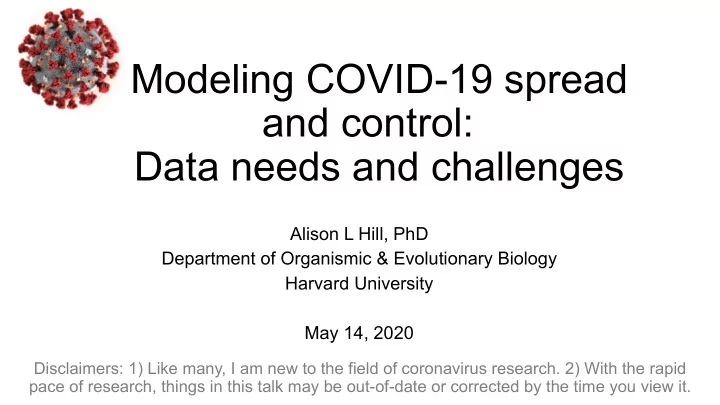

Modeling COVID-19 spread and control: Data needs and challenges Alison L Hill, PhD Department of Organismic & Evolutionary Biology Harvard University May 14, 2020 Disclaimers: 1) Like many, I am new to the field of coronavirus research. 2) With the rapid pace of research, things in this talk may be out-of-date or corrected by the time you view it.
Summary of the epidemic • A newly-recognized virus ( SARS-CoV-2 ) which causes a disease ( COVID-19 ) characterized by pneumonia and respiratory failure • Since recognition as a disease syndrome in Dec 2019 and as a novel coronavirus (Jan 2019), has spread to nearly every country in the world • As of May 14, 2020 12:48 UTC-5, ~4,400,000 recognized cases and ~300,000 deaths • Like now ranked in Top 5 viral causes of death worldwide
About me • Infectious disease modeler focusing on HIV/AIDS and drug resistant infections ! " # = ! # " !(") Model !(#)
Contributions to COVID-19 modeling • Assisting regional health authorities, NGOs, consultants, educators, and other scientists with COVID-19 modeling projects Interactive modeling app available at: https://alhill.shinyapps.io/COVID19seir/
Role of models in COVID-19 epidemic • Making short-term projections (exponential growth) • Highlighting the risk of healthcare capacity overflow • Promoting the idea of “flatten the curve” • Motivating the implementation of strong interventions • Projecting the course of the epidemic beyond spring 2020 • Estimating the potential impact of seasonality • Estimating the total burden of infection • Inferring the efficacy of interventions
Ingredients of COVID-19 models Healthcare resources available Transmission networks Clinical course of infection ) ' ) ( R ) * ! " # $ # % & ' & ( Recovered # S E I 1 I 2 I 3 + Susceptible Incubation period Mild infection Severe infection Critical infection D e.g. cough/fever e.g. pneumonia => e.g. ARDS => ICU, Interventions hospitalization, mechanical ventilation supplemental O 2 Death
What are the data needs for COVID-19 models?
Clinical course of infection R S E I 1 I 2 I 3 • Needs: D • Duration of each stage of infection • Probability of progression/death/recovery at each stage • % asymptomatic infections • Infectiousness of each stage of infection (relationship to viral load, age) • Gold standard: • Detailed cohort study with long-term follow-up • Contact tracing studies • Universal and centralized reporting • Challenges • Estimating these quantities from population-level cumulative prevalence
Transmission networks • Potential networks vs realized network • Questions • Who contacts whom, and where, for how long, how often, etc? • What type of contact is most risky? (e.g. physical proximity, indoor vs outdoor, duration, surfaces) • What setting is most important for transmission? (e.g. home, work, retail) • May depend on pre/post intervention, location, age, etc • How important is transmission in hospitals? • Gold standard • Contact surveys; proximity tracking; contact tracing; genetic epidemiology • Challenges: Privacy, resources, reporting infrastructure,
Healthcare requirements vs capacity • Needs • % cases requiring different levels of care vs age, comorbidity • Baseline and surge capacity for PPE, hospital beds, ICU beds, ventilators, masks for the general public, etc • Staffing needs • Geographic variation in resources (esp. in rural areas, low-income countries) • Willingness/ability to access care • Impact on non-COVID19 health care delivery • Gold standard • National databases tracking medical resources • Real-time reporting of COVID-19 utilization • Challenges • Finding/compiling alternative data sources
Interventions (“non-pharmaceutical”) • Includes: mask wearing, case isolation, quarantine, school closures, closing of retail/dining, work-from-home policies, stay-at-home orders, complete lockdown • Questions • What is the evidence base for interventions? • What was implemented, when and where? • How much do they reduce contacts relevant to transmission? • What level of adherence is there to interventions? • Are they working? Which ones? • Gold standard: RCTs, surveys, knowledge of transmission networks • Challenges: Relating alternative data sources to modeled “proportion al reduction in transmission rate”
What about the data we currently have? • Current data: cases + deaths by region • Pros • easily accessible to anyone from a central source • simple metrics that people understand • reported from centralized, official sources • Cons • no individual level data • delays in time of onset or time of death • Imperfect reporting/testing • outcome of infection unknown • who is in hospital/ICU? • detailed geographic or age info
Thanks! • Anjalika Nande, Ben Adlam, Mike Levy, Sherrie Xie, Chris Rehman, Justin Sheen, Julianna Schinnick, Melanie Prague, Chloe Pasin, Irene Ballelli, Sam Scarpino, Moritz Kraemer
Recommend
More recommend